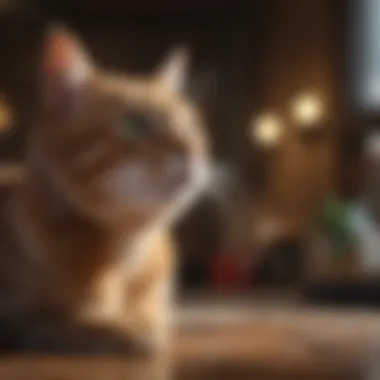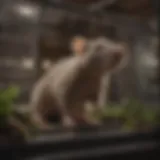Effective Solutions for Wheezing Cats: Alleviating Feline Respiratory Distress


Wheezing cats can be distressing for both pets and their owners. This article aims to explore various remedies and treatments that can help alleviate wheezing in felines, providing valuable insights to improve the quality of life for these furry friends.
Understanding Wheezing in Cats
Before delving into remedies, it is essential to understand why cats wheeze. Wheezing is often a symptom of an underlying health issue such as asthma, allergies, respiratory infections, or heartworm disease. Observing your cat's wheezing patterns and seeking veterinary advice are crucial steps in addressing this issue effectively.
Environmental Triggers and Allergies
Environmental factors like dust, pollen, cigarette smoke, or mold can trigger wheezing in cats with sensitive respiratory systems. Identifying and minimizing exposure to these triggers can significantly reduce episodes of wheezing. Additionally, certain food allergies can also manifest as respiratory symptoms in cats, emphasizing the importance of a balanced diet.
Home Remedies and Treatments
Several home remedies can help ease a cat's wheezing episodes. Humidifiers can improve air quality and reduce respiratory irritation, while regular grooming can minimize exposure to allergens. In cases of acute wheezing, sitting with your cat in a steamy bathroom can provide temporary relief by moistening the airways.
Veterinary Care and Medications
For persistent or severe wheezing, consult a veterinarian for a proper diagnosis and treatment plan. Medications such as bronchodilators, corticosteroids, or antihistamines may be prescribed to manage respiratory conditions effectively. Regular check-ups and monitoring are essential to track your cat's progress and adjust treatment as needed.
Lifestyle Changes and Monitoring
In addition to medical intervention, lifestyle changes can play a significant role in managing wheezing in cats. Keeping your home clean and dust-free, avoiding smoking indoors, and providing a well-balanced diet are crucial preventive measures. Monitoring your cat's breathing patterns and overall health can help detect any recurring wheezing early on, enabling prompt intervention.
Conclusion
Understanding Wheezing in Cats
Understanding wheezing in cats is crucial for pet owners to address potential health issues in their feline companions. Wheezing can signal various underlying problems, ranging from respiratory infections to allergies and asthma. By closely observing and comprehending the reasons behind wheezing, caregivers can take appropriate actions to improve their cat's well-being and comfort.
Causes of Wheezing
Respiratory Infections
Respiratory infections are a common trigger for wheezing in cats, often leading to inflammation in the respiratory tract. This inflammation can result in narrowed airways, making breathing difficult for felines. Recognizing the signs of respiratory infections, such as sneezing, nasal discharge, and fever, is vital in diagnosing and treating this condition promptly.
Allergies
Allergies play a significant role in inducing wheezing episodes in cats. Sensitivities to certain allergens can cause respiratory distress and wheezing in felines. Identifying allergens like pollen, dust mites, or certain foods can aid in minimizing allergic reactions and subsequently reducing wheezing incidents.
Asthma
Asthma is another prevalent cause of wheezing in cats, characterized by inflammation and constriction of the airways. Cats with asthma may experience wheezing, coughing, and difficulty breathing during flare-ups. Understanding asthma triggers and providing appropriate treatment can help manage wheezing in affected felines.


Foreign Objects
The inhalation of foreign objects can also lead to wheezing in cats. Small items like string, grass, or toys can become lodged in the throat or airways, obstructing normal breathing and causing wheezing sounds. Promptly removing foreign objects by a veterinarian is essential to prevent complications and alleviate wheezing symptoms.
Obesity
Obesity is a lesser-known but significant contributor to wheezing in cats. Excess weight can put pressure on the respiratory system, leading to restricted breathing and wheezing. Maintaining a healthy weight through proper diet and exercise is crucial in preventing obesity-related wheezing episodes.
Symptoms to Watch for
Labored Breathing
Labored breathing is a key symptom indicating respiratory distress in cats. When a cat exhibits rapid, shallow breathing or struggles to catch its breath, it signifies an underlying issue that requires immediate attention. Monitoring breathing patterns and seeking veterinary care can help address the root cause of labored breathing.
Coughing
Coughing is another prominent symptom commonly associated with wheezing in cats. Persistent or recurrent coughing fits can indicate respiratory irritation or inflammation. Identifying the triggers of coughing, such as allergens or infections, is essential in devising a targeted treatment plan.
Increased Respiratory Rate
An increased respiratory rate in cats, where breathing becomes fast and shallow, often accompanies wheezing episodes. This elevated breathing pattern suggests respiratory distress and the need for intervention to alleviate discomfort and stabilize the cat's breathing. Surveillance of respiratory rates can aid in tracking the progression of wheezing symptoms.
Lethargy
Lethargy, or unusual fatigue and lack of energy, is a concerning symptom linked to wheezing in cats. Cats experiencing wheezing may feel weak and lethargic due to compromised breathing and reduced oxygen intake. Identifying and addressing the underlying cause of lethargy can help improve the cat's overall well-being and quality of life.
Home Remedies for Wheezing Cats
Humidity Control
Use of Humidifiers
Exploring the use of humidifiers in addressing wheezing in cats is vital to maintaining optimal moisture levels in the environment. Humidifiers help prevent airway irritation and soothe respiratory distress in cats prone to wheezing episodes. The key characteristic of using humidifiers lies in their ability to regulate humidity levels, creating a conducive atmosphere for cats with respiratory issues. Its popularity stems from the proven benefits of moist air in easing breathing difficulties and reducing wheezing episodes. While the unique feature of humidifiers lies in their simplicity and effectiveness, it is essential to monitor humidity levels carefully to avoid excess moisture, which could lead to other health concerns for cats.
Steam Treatment
Introducing steam treatment as a part of home remedies for wheezing cats showcases its significance in providing immediate relief to felines experiencing respiratory distress. Steam treatment helps clear congestion in the airways, promoting easier breathing and alleviating wheezing symptoms. The standout feature of steam treatment lies in its ability to act as a natural decongestant, aiding in the loosening of mucus and opening up blocked air passages. This popular choice for managing wheezing in cats offers a non-invasive and gentle solution, particularly beneficial for cats with sensitive respiratory systems. However, it is crucial to use steam treatment cautiously to prevent burns or scalds, ensuring the safety and comfort of the feline recipients.
Clean Environment
Regular Cleaning
Emphasizing regular cleaning practices as a part of home remedies for wheezing cats underscores the importance of maintaining a clean and hygienic living space. Regular cleaning helps remove dust, allergens, and other irritants that could trigger or worsen wheezing in cats. The key characteristic of regular cleaning lies in its ability to reduce environmental factors that contribute to respiratory issues, promoting a healthier indoor environment for felines. Its widespread popularity is due to the immediate benefits of cleaner air for cats, leading to improved respiratory function and decreased wheezing episodes. While the unique feature of regular cleaning lies in its simplicity and accessibility, it is essential to use pet-safe cleaning products and techniques to ensure the well-being of cats.


Dust-Free Zone
Creating a dust-free zone within the home environment emerges as a crucial strategy in mitigating wheezing symptoms in cats prone to respiratory distress. Designating specific areas as dust-free zones helps minimize the presence of airborne particles that could exacerbate wheezing episodes in sensitive feline companions. The key characteristic of a dust-free zone lies in its targeted approach to reducing potential triggers for respiratory issues, fostering a clean and healthy space for cats to thrive. Its popularity stems from the noticeable improvement in respiratory comfort for cats within a reduced dust environment. While the unique feature of a dust-free zone lies in its tailored design for respiratory support, maintaining consistency in dust control measures is essential to sustain a wheeze-free environment for felines.
Diet and Nutrition
Balanced Diet
Prioritizing a balanced diet as a fundamental element of home remedies for wheezing cats underscores the role of nutrition in supporting overall health and well-being. A balanced diet rich in essential nutrients promotes immune function, respiratory health, and overall vitality in cats prone to wheezing. The key characteristic of a balanced diet lies in its ability to provide comprehensive nutrition, addressing specific dietary requirements for felines with respiratory concerns. Its popularity is attributed to the proven benefits of a well-rounded diet in reducing inflammation, strengthening respiratory function, and minimizing wheezing episodes. While the unique feature of a balanced diet lies in its immediate impact on cat health and longevity, consulting with a veterinarian for tailored dietary recommendations is essential to meet individual feline needs.
Omega-3 Fatty Acids
Incorporating omega-3 fatty acids into the diet of wheezing cats highlights their essential role in managing inflammation and supporting respiratory health. Omega-3 fatty acids offer anti-inflammatory properties that can help reduce airway inflammation and alleviate breathing difficulties in cats with wheezing issues. The key characteristic of omega-3 fatty acids lies in their protective effect on respiratory tissues, potentially reducing the frequency and severity of wheezing episodes. Their popularity as a dietary supplement for wheezing cats stems from the growing body of research supporting the therapeutic benefits of these essential fats. While the unique feature of omega-3 fatty acids lies in their multi-faceted support for respiratory function, ensuring proper dosage and quality of supplements is crucial for optimizing health outcomes for wheezing felines.
Herbal Remedies
Echinacea
Exploring the use of Echinacea as an herbal remedy for wheezing cats sheds light on its immune-boosting and anti-inflammatory properties. Echinacea may help strengthen the immune system and reduce airway inflammation, potentially improving respiratory function in cats experiencing wheezing symptoms. The key characteristic of Echinacea lies in its natural healing capabilities, offering a gentle yet effective solution for respiratory support in felines. Its popularity as an herbal remedy for wheezing cats is rooted in traditional medicine practices and contemporary research highlighting its therapeutic benefits. While the unique feature of Echinacea lies in its holistic approach to respiratory wellness, consulting with a veterinarian before administration is recommended to ensure safe and appropriate usage.
Licorice Root
Introducing Licorice Root as an herbal remedy for wheezing cats underscores its soothing properties and potential respiratory benefits. Licorice Root may help alleviate airway irritation, facilitate easier breathing, and reduce coughing in cats with wheezing issues. The key characteristic of Licorice Root lies in its mucolytic and anti-inflammatory actions, making it a valuable herbal ally in managing respiratory distress in felines. Its popularity as a natural remedy for wheezing cats stems from traditional medicinal practices that recognize its therapeutic qualities. While the unique feature of Licorice Root lies in its gentle yet effective respiratory support, ensuring the quality and source of the herbal preparation is essential for optimal safety and efficacy in feline care.
Medical Interventions for Wheezing Cats
In the realm of feline health, understanding the significance of medical interventions for wheezing cats is paramount. When a cat experiences wheezing, it can be indicative of potentially serious underlying conditions, prompting the need for swift and effective treatment. Exploring medical interventions equips cat owners with the knowledge and tools required to address these issues comprehensively. By delving into medical interventions, one can uncover solutions that aim to improve the respiratory health of feline companions.
Professional Diagnosis
Veterinary Examination
Delving into the realm of professional diagnosis, the veterinary examination emerges as a crucial aspect of evaluating and diagnosing wheezing in cats. A veterinary examination entails a thorough assessment of the cat's overall health, focusing on respiratory patterns, lung sounds, and potential triggers for wheezing. The detailed examination conducted by a qualified veterinarian aids in identifying underlying conditions, determining the severity of wheezing, and outlining a tailored treatment plan. The meticulous nature of the examination ensures that no red flags are overlooked, enabling a targeted and effective approach towards mitigating wheezing in cats.
Imaging Tests
Complementing the veterinary examination, imaging tests play a pivotal role in elucidating the root cause of wheezing in cats. By utilizing imaging techniques such as X-rays or ultrasounds, veterinarians can visualize the internal structures of the respiratory system, pinpointing abnormalities or obstructions that may contribute to wheezing. These tests provide invaluable insights into the cat's pulmonary health, aiding in accurate diagnosis and treatment planning. While imaging tests offer a non-invasive means of assessment, they bolster the diagnostic process, guiding veterinarians towards tailored interventions.
Medication Options
Bronchodilators


Within the spectrum of medication options, bronchodilators emerge as a critical component in managing feline wheezing. Bronchodilators work by relaxing the muscles around the airways, facilitating improved breathing and alleviating respiratory distress. With their ability to expand the air passages, bronchodilators enhance airflow, thereby reducing wheezing episodes and enhancing overall respiratory function. Despite their efficacy, bronchodilators require careful administration and monitoring to ensure optimal outcomes for wheezing cats.
Corticosteroids
Another essential medication option for wheezing cats is corticosteroids, which exert anti-inflammatory effects to reduce airway inflammation and alleviate respiratory symptoms. Corticosteroids play a pivotal role in managing conditions such as asthma or allergic reactions that manifest as wheezing in felines. By targeting the underlying inflammatory response, corticosteroids help in improving breathing patterns and enhancing the quality of life for wheezing cats. However, their prolonged use necessitates close veterinary supervision to monitor for potential side effects and adjust dosage as needed.
Surgical Procedures
Airway Clearance Surgery
In cases where conservative treatments prove ineffective, airway clearance surgery emerges as a viable option for addressing severe respiratory issues in wheezing cats. Airway clearance surgery aims to remove obstructions or abnormalities within the respiratory tract, restoring optimal airflow and reducing wheezing episodes. This surgical intervention is tailored to the specific needs of each feline patient, with the goal of improving respiratory function and enhancing overall well-being. While airway clearance surgery presents a more invasive approach, it offers a potential solution for cats with persistent or severe wheezing issues.
Tumor Removal
When wheezing in cats stems from the presence of tumors or growths within the respiratory system, tumor removal surgery becomes a crucial intervention. By surgically excising the abnormal tissue, veterinarians can alleviate respiratory obstruction, promote healthy breathing, and mitigate wheezing episodes. Tumor removal surgery is instrumental in addressing life-threatening conditions that impede respiratory function, emphasizing the importance of timely intervention and comprehensive care for wheezing felines.
Lifestyle Adjustments for Wheezing Cats
For wheezing cats, lifestyle adjustments can play a crucial role in improving their overall well-being. These adjustments encompass a range of changes that aim to alleviate stress, promote physical activity, and ensure regular monitoring of the cat's health. By focusing on lifestyle modifications, cat owners can create a conducive environment that supports their furry companions' health and happiness.
Reducing Stress
Quiet Environment
The concept of a quiet environment is pivotal in reducing stress levels in wheezing cats. A quiet environment refers to a space that is free from loud noises, disturbances, and constant commotion. This kind of setting allows cats to relax, unwind, and find solace, which is essential for managing their respiratory health. The peaceful nature of a quiet environment can help cats breathe more easily and reduce the chances of exacerbating their wheezing symptoms.
Interactive Play
Interactive play is a stimulating way to engage wheezing cats and alleviate their stress. Through interactive play sessions, cats can release pent-up energy, reduce anxiety, and foster a bond with their human companions. This form of engagement not only provides physical and mental stimulation but also promotes relaxation and reduces the likelihood of respiratory issues flaring up. Interactive play offers a holistic approach to cat care by addressing both physical and emotional needs.
Regular Exercise
Physical Activity
Implementing regular physical activity is crucial for wheezing cats to maintain good health. Physical activity includes exercises that encourage movement, such as gentle walks or low-impact games. By engaging in physical activity, cats can strengthen their respiratory muscles, improve circulation, and boost overall well-being. This aspect of lifestyle adjustment is beneficial for enhancing lung function and reducing the frequency of wheezing episodes.
Indoor Games
Indoor games provide a safe and controlled environment for wheezing cats to engage in playful activities. These games cater to the cats' need for mental stimulation, exercise, and entertainment within the confines of their home. Indoor games keep cats engaged, active, and mentally sharp, contributing to their physical fitness and emotional contentment. Encouraging indoor games as part of a cat's routine can have positive effects on their respiratory health.
Monitoring Health
Regular Vet Visits
Regular visits to the veterinarian are essential for monitoring the health status of wheezing cats. These visits allow for thorough check-ups, disease prevention, and early detection of any respiratory issues. Veterinarians can provide guidance on managing wheezing symptoms, adjusting treatment plans, and ensuring the cat's respiratory health remains stable. Regular vet visits are instrumental in maintaining the overall well-being of wheezing cats.
Observing Symptoms
Observing symptoms on a regular basis is key to identifying any changes or issues concerning wheezing cats. This proactive approach involves monitoring breathing patterns, coughing frequency, and overall activity levels. By closely observing symptoms, cat owners can intervene promptly if any complications arise, seek timely medical attention, and prevent potential exacerbation of respiratory conditions. Awareness and vigilance in symptom observation are fundamental in caring for wheezing cats.







